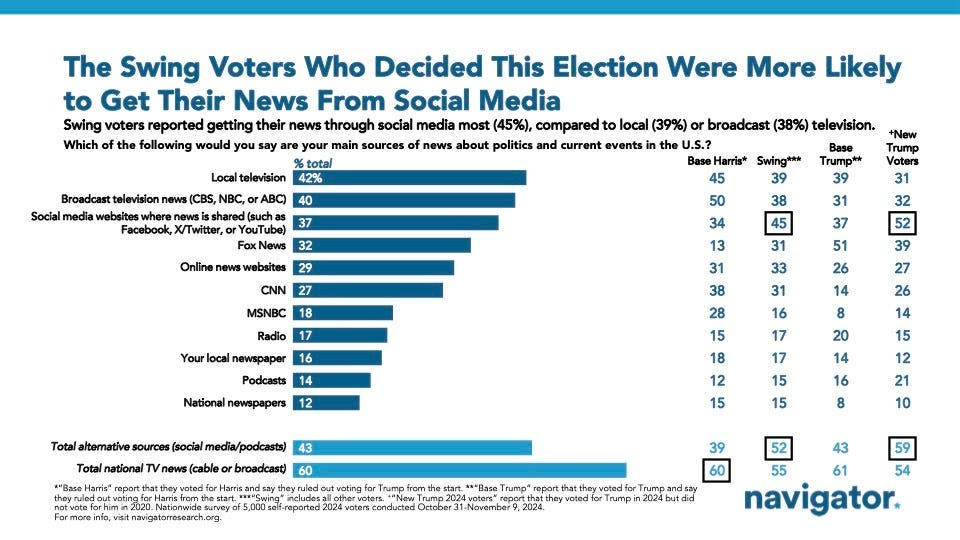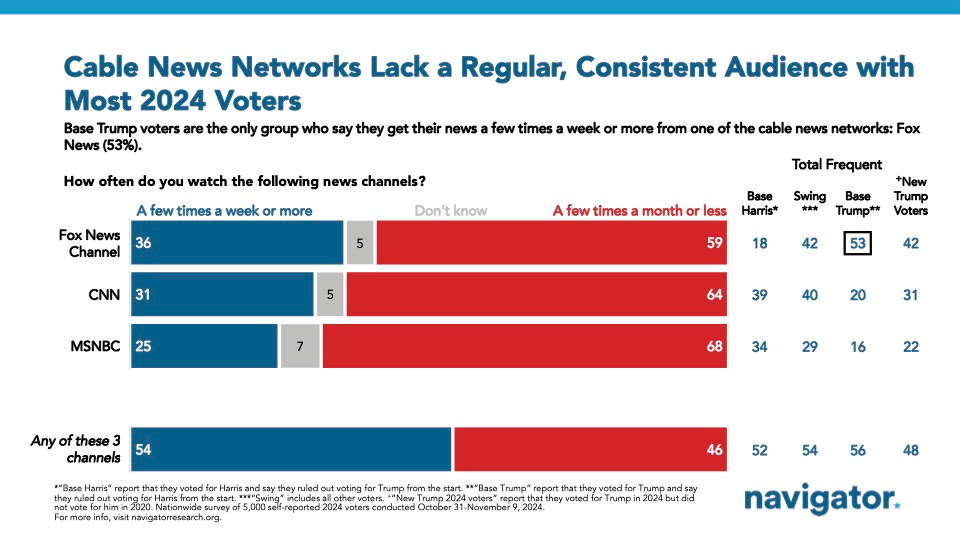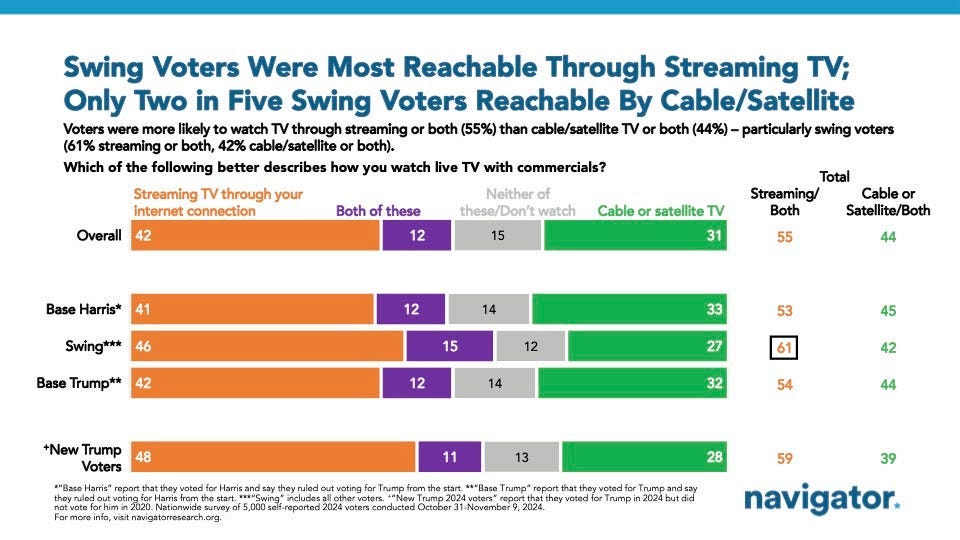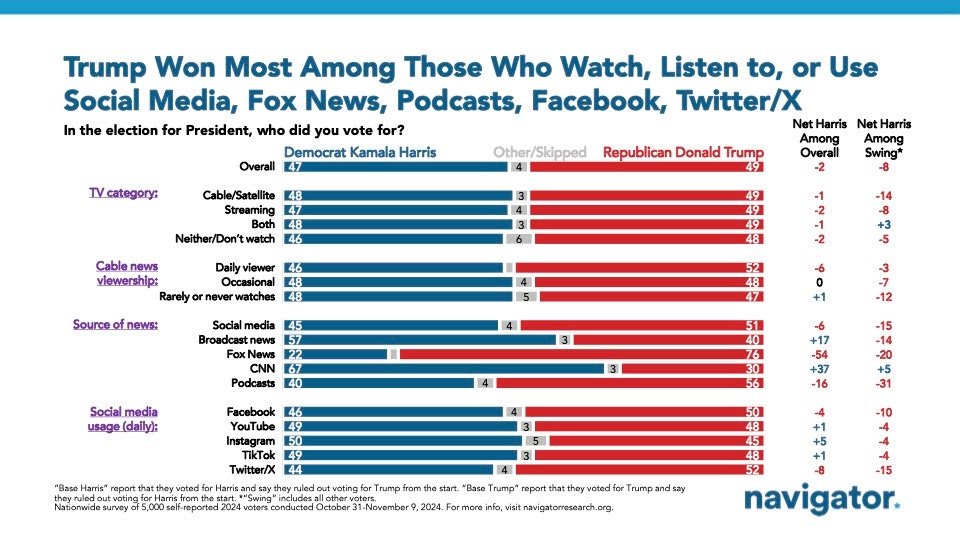Why Republicans are Winning the Message War
A new poll shows that swing voters are not hearing what we have to say.
We are in the midst of a big, vituperative debate within the Democratic Party about Harris’s campaign message. Was she insufficiently populist? Too moderate? Not moderate enough? Should she have talked inflation more? What about abortion and democracy?
I could go on forever. The chatter is endless. There is no question that the Democratic message needs work. Voters who supported us for years left us for Trump. We considered ourselves the party of the working class, and the working class voted for the other guy. Clearly, we have a message (and a policy) problem.
However, a new post-election study shows that Democrats have more than a message problem. We have a message delivery problem. The voters who decided the election simply weren’t hearing what Democrats were saying.
Democrats at every level — from elected officials to communications staffers to activists posting about politics online — should read this election exit survey of 5000 voters from Navigator Research.
This post is part of a series of posts discussing how Trump out messaged us in the 2024 election and what we can do in the future. If you want to follow along, please consider becoming a paid subscriber.
If you find the information in this post useful, please share it with your network.
Swing Voters Don’t Consume Traditional News
Trump didn’t do a single legacy media interview for the last month of the campaign. He didn’t sit down with a cable network. He attended no roundtables with reporters or sit downs with local TV anchors in key markets. He backed out of interviews with 60 Minutes, CNBC, and NBC News. Trump also turned down a primetime CNN townhall in the final weeks. Instead, he talked to Joe Rogan and other political podcasters.
It paid off.
Polling before and after the election showed Harris performing well with voters who consume the most news, and conversely, Trump running up big margins with those who consume the least.
However, the Navigator story offers more detail on the media diets of the voters who decided the elections. The study focuses on two types of voters — swing voters and new Trump voters. Swing voters are people who didn’t rule out voting for either candidate from the start and new Trump voters are people who voted for Trump in 2024 but didn’t vote for him in 2020. This last group includes people Trump brought into the electorate and those who switched from Biden to Trump (There is overlap between the two groups).
What’s even more surprising is that swing and new Trump voters are most likely to get their news from social media. Very few of them are getting news from legacy media. Only 16% of swing voters watch MSNBC and only 15% get their news from national newspapers. Think of all of the time spent fretting about New York Times headlines and stories — none of the voters who were on the fence ever saw them. It was just an internal conversation among people who decided to vote against Donald Trump years ago.
CNN loves to tout the finding that 31% of swing voters get news from their network, but their low ratings make me quite skeptical that they are regular viewers. More likely, they turn to CNN during major news events.
The main takeaway from all of this data is that legacy media is an inefficient way to reach persuadable voters and any communications strategy centered on those traditional outlets is doomed to fail. The Harris campaign did lots of innovative non-traditional stuff like the Call Her Daddy and All the Smoke podcasts. However, I look back at the time spent on legacy media, like the CNN town hall and the interview with NBC News, and wonder what the upside was.
The Move to Streaming is a Big Deal
Swing voters are also more likely to have cut the cable cord and depend on streaming services. Only 27% of swing voters watch cable or satellite TV.
Republicans have a significant messaging advantage. They have Fox, an array of Right Wing media outlets, and Right or MAGA-adjacent influencers tend to dominate on YouTube and TikTok. In recent elections, Democrats leveled the playing field by running more paid advertising. We have a better grassroots fundraising machine, so our campaigns have more money to spend. The GOP tries to balance the scales with billionaire-funded Super PACs, but because of campaign finance laws, campaign funds go much further than Super PAC money. An ad from a Super PAC costs five times as much as one from a campaign in many markets during the 2024 cycle.
If more than half of swing voters have cut the cord, it becomes much harder for Democrats to reach them through paid advertising. Most streaming services offer an ad tier, where consumers can pay less per month but have to watch commercials. However, reaching people through these services is more complicated than through linear television. Netflix is the biggest streamer by far, yet most Netflix users aren’t on the ad tier; and even for those who are, Netflix is one of a handful of services that don’t allow political ads.
Relying on TV ads to reach voters is a suboptimal strategy, and a very inefficient way to reach the voters we need most.
The Podcast Election
In the runup to and aftermath of the election, a number of observers referred to 2024 as the “podcast election.” While a little oversimplified, that designation made sense. Other than the debate, the two most high-profile media moments were the Rogan and Call Her Daddy interviews. While Harris did several podcasts, Trump made podcasts the central focus of his strategy. Unsurprisingly, according to Navigator Research, Trump won swing voters who listen to podcasts by 31 points.
While the polls show that only 16% of swing voters get their news from podcasts, it seems that podcasts were particularly influential in their choice. This makes sense for two reasons. First, listeners tend to trust podcast hosts more than any other media figures because of the intimacy of the medium. Second, podcast clips particularly those from Rogan and Alex Cooper, the host of Call Her Daddy, tend to get a lot of engagement on TikTok, Instagram, and YouTube. Even people who don’t subscribe to a particular podcast (or any podcast) were likely to see some of these interviews.
As a podcast co-host myself, I am undeniably biased about the importance of podcasts. However, long-form audio is a growing force in political media
Democrats need a better, more compelling story to tell voters. We also need new, more populist policies that address people’s dissatisfaction with the economy and the political system. But even if we solve that problem and introduce the perfect message, it won’t matter if no one hears it. Fixing our problem begins with understanding why so few people heard what we had to say in this last election.






It’s nice to have the actual numbers but i feel like we already knew the trends here. My concern is when we say “democrats need to do….”, who exactly are we talking about? On the republican side, you can name 3 or 4 people that craft the message that every politician follows (Bannon, Kirk, etc.) Who is that for democrats? We just spent months talking about the existential crisis that Trump represents and now post election, we’re just following the same normal schedule. The DNC will elect its new chair in February. Why wait so long? If ever there was time for war room strategy/ thinking it’s now. The lack of a cohesive message and delivery behind Trump’s nominees is infuriating. We just continue to waste valuable time.
So first, even mentioning CNN and MSNBC as options for news access shows a fundamental misunderstanding of those of us here in the cheap seats. Second, please stop with the darn polls. Yes, we make fun of trump because he relies on feelings instead of data but that is EXACTLY why he won. Because so do most Americans. We can tell them facts and cite statistics and prove our theories but all most people care about is how it FEELS to them. So, here are my suggestions that no one will take:
1. Dems need to have as many conversations with reality tv directors, writers, and producers as they can. Like seriously, after a debate, don’t wait to poll people. Have them text 29473 to vote for who won. trump won in part because he’s the one who spiked everyone’s adrenaline and cortisol. The person we all remember most from Survivor is Richard (sorry Jon) and there is a reason for that.
2. A serial podcast that looks at all the true crimes of all trump’s associates.
3. More roadside billboards for Dem candidates. Driving in the US felt like and assault for those of us who lean left bc in most places, the ONLY signs we saw were for trump
4. Dems need to figure out how to show up on right leaning media and not get their asses kicked. Which probably means being okay with being thought of as an asshole. The right relies on the rest of us following the rules of civility so they don’t have to
5. Dems don’t need more populist policies. Their policies are as populist as they can be. They just need to talk about them as populists. And actually act like populists. Lofty rhetoric is not populist. Treatises and polls and quantitative data are not populist. It’s not the message, it’s the delivery